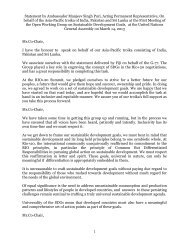STATE OF THE WORLD'S CITIES 2012/2013 Prosperity
STATE OF THE WORLD'S CITIES 2012/2013 Prosperity
STATE OF THE WORLD'S CITIES 2012/2013 Prosperity
You also want an ePaper? Increase the reach of your titles
YUMPU automatically turns print PDFs into web optimized ePapers that Google loves.
oad infrastructure in Africa poses a major challenge to<br />
mobility and prosperity and is an important source of<br />
congestion. In addition to this, poor maintenance is a major<br />
problem: only 18.5 per cent of experts across African cities<br />
believe that infrastructure is systematically maintained.<br />
Some African cities have taken innovative steps to<br />
enhance mobility and tackle traffic congestion. Lagos<br />
introduced Bus Rapid Transit (BRT) in 2008. South Africa’s<br />
Gauteng Province launched in 2010 the ‘Gautrain’, a stateof-the-art<br />
80-km mass rapid transit railway system. Cities<br />
like Nairobi and Dakar have achieved significant progress<br />
in the development of road infrastructure increasing<br />
prosperity prospects.<br />
Significant improvements in road infrastructure in<br />
Asian cities: In recent years, various Asian countries have<br />
embarked on ambitious programmes of road development<br />
and expansion. In 1997, India started the Golden<br />
Quadrilateral motorway to connect the country’s largest<br />
cities – Kolkata, Delhi, Mumbai and Chennai. An East-<br />
West corridor has also been recently completed, not just<br />
improving connections between cities but also opening up<br />
the hinterlands. In China, cities have been at the forefront<br />
of massive infrastructure development with emphasis on<br />
new roads and subway systems. The urban road network<br />
more than doubled between 1990 and 2003, 19 largely<br />
contributing to urbanization and economic growth. Cities<br />
like Beijing and Shanghai have extended infrastructure to<br />
suburban areas in a bid to match spatial expansion. Beijing<br />
currently allocates 30 per cent of its construction budget to<br />
mass transit20 and Shanghai spends 10 per cent of its GDP<br />
on infrastructure, of which 40 per cent is for transportation.<br />
Singapore’s public transportation system is considered to be<br />
one of the most integrated and well-planned in the world.<br />
In addition, adequate facilities are provided for pedestrians<br />
with a safe and comfortable<br />
walking environment that<br />
enhances quality of life.<br />
In major Asian<br />
Massive economic<br />
FACT cities, some<br />
growth in Asia, particularly<br />
11 per cent of land<br />
space is devoted to<br />
China and India, has<br />
roads, well below the spurred spectacular<br />
20–30 per cent rate increases in the numbers<br />
common in US cities. of motor vehicles. This<br />
has contributed to traffic<br />
congestion, air and<br />
noise pollution, road<br />
accidents and energy use<br />
in the region. In India,<br />
21<br />
In Indian cities, the<br />
proportion varies from<br />
21 per cent in Delhi to<br />
11 per cent in Mumbai<br />
to five per cent in<br />
Kolkata. 22<br />
53<br />
FACT<br />
Urban Infrastructure: Bedrock of <strong>Prosperity</strong><br />
A notable feature of the transport system in African cities<br />
is the virtual absence of State-operated public transport.<br />
The private sector is the major provider of transport services,<br />
often in the form of secondhand mini- and microbuses, shared<br />
taxis, and more recently commercial motorcycles. 17 The needs of<br />
pedestrians are hardly taken into consideration despite the fact<br />
that walking accounts for over 60–70 per cent of trips in cities<br />
such as Conakry, Douala or Kinshasa. 18<br />
the number of passenger<br />
vehicles increased by nine<br />
million, or 12.9 per cent,<br />
between 2007 and 2008. 23<br />
In China, the number of<br />
vehicles increased 10-fold<br />
between 1990 and 2002; of<br />
particular significance is the<br />
increase in motorcycles and<br />
scooters, which increased<br />
from just 200,000 in 1981<br />
to 50 million in 2002.<br />
Latin America and<br />
the Caribbean region<br />
features the highest level<br />
of motorization in the<br />
developing world: the<br />
region has five times more<br />
cars than sub-Saharan<br />
Africa and Asia, and<br />
about twice as many as the<br />
Middle East and North<br />
Africa. 26 Motorization<br />
in the region increased from 100 vehicles per 1,000 in<br />
1990 to 155 in 2005, before reaching 169:1,000 in 2008.<br />
Rising incomes, expanding middle classes, high levels of<br />
urbanization, an expanding local automobile industry, and<br />
availability of low-cost vehicles are the major forces driving<br />
motorization in the region. As a result, cities in the region<br />
experience severe traffic congestion. A great majority<br />
of experts in the UN-Habitat survey (over 80 per cent)<br />
indicate that the roads in their respective cities are<br />
congested, costing the region USD2.2 billion a year in lost<br />
productivity. 27 In India, public<br />
FACT transport accounts<br />
for only 22 per cent<br />
of urban trips among<br />
ever-increasing numbers<br />
of private vehicles.<br />
Time spent in traffic deteriorates quality<br />
of life, causing pollution, traffic accidents, increased fuel<br />
consumption and emission of greenhouse gases.<br />
In São Paulo, public transport as a share of all trips<br />
declined from 46 per cent in 1977 to 33 per cent in 1997 and<br />
24 A<br />
greater proportion of these<br />
vehicles are concentrated<br />
in only a few cities: New<br />
Delhi, Mumbai, Kolkata<br />
and Bangalore, which host<br />
five per cent of India’s<br />
population but 14 per cent<br />
of registered vehicles. 25<br />
Cities must<br />
POLICy address the<br />
road congestion problems<br />
that adversely affect their<br />
prosperity




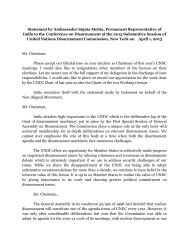
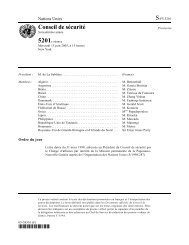

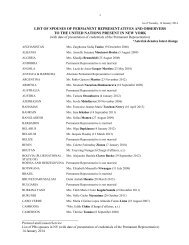
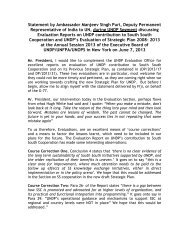

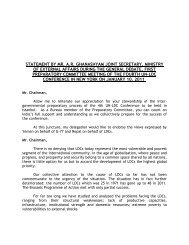
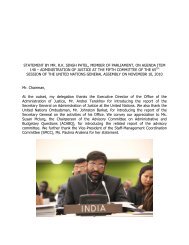

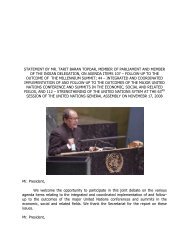

![1 statement by dr.[mrs] kakoli ghosh dastidar - Member States Portal](https://img.yumpu.com/27526598/1/190x245/1-statement-by-drmrs-kakoli-ghosh-dastidar-member-states-portal.jpg?quality=85)
